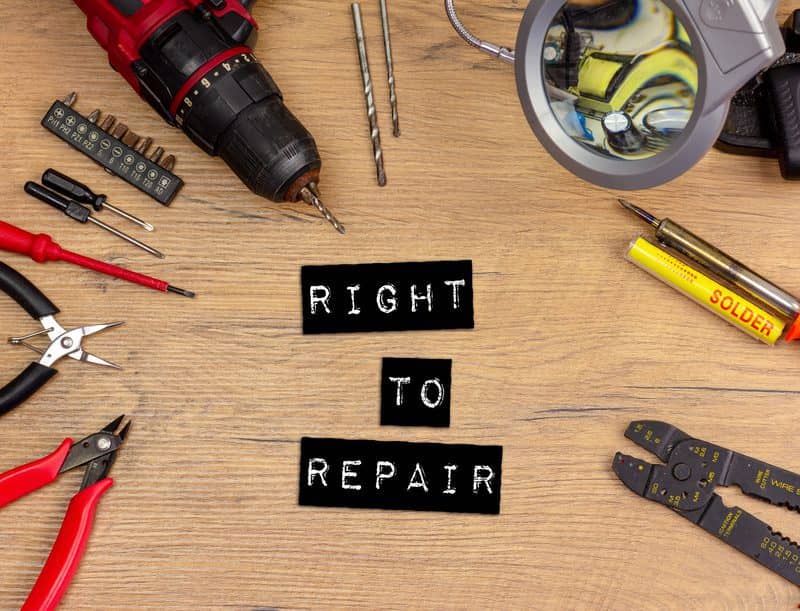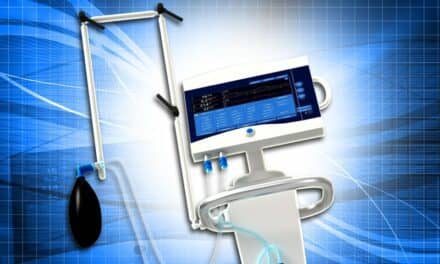The Right to Repair movement is gaining momentum. But can the medical device segment of this debate make meaningful changes to the system for medical device repair any time soon?
By Melanie Hamilton-Basich
The Right to Repair movement is not new. But now there seems to be a renewed momentum.
“I would say right now it definitely feels like it is an active movement,” says Wesley Reid, CHTM, CBET, CRES, S Plus. “It is something that is alive, and a lot of people are supporting it.” Reid was initially trained as a biomedical technician in the military and now serves as director of tech management/Entech at Banner Health. He counts himself among those supporters.
On its surface, the right to repair is a simple concept. The idea is that if you own a piece of property, you should have the right to fix that equipment. And for consumer products, it often is that straightforward.
But when you get into commercial equipment, the owner is not necessarily the person fixing a product, and the discussion becomes more contentious. It involves a whole host of stakeholders. When it comes to healthcare technology management (HTM) and the medical right to repair, that list includes hospitals, biomeds, third-party service providers, original equipment manufacturers (OEMs), and even patients. And everyone has an opinion.
Up for debate: Who has the right to decide who can repair equipment, as well as what tools and information the OEM must provide and to whom, and what exactly constitutes a repair.
Change Through Right to Repair Legislation
The broader application of the philosophy that owners should have a right to repair their property is seeing success with consumer products like cell phones. There’s even been success for medical right to repair in the form of Colorado’s Bill HB23-1011, signed into law in April, which allows people to fix their power wheelchairs—in addition to all agricultural equipment, another battleground sector. At the time of this writing, a state Medical Equipment Right to Repair Act, H752, had been introduced in North Carolina.
These wins are giving some supporters hope that the medical right to repair movement will gain more traction. For most of these proponents, their goal is for hospital-based biomeds and the third-party service providers they hire to be given more access to information, software, and parts by the OEMs at a fair and reasonable price. That way, they can repair hospital equipment without relying on OEM service technicians to do so.
“There were 28 different states that considered some sort of right to repair legislation this year, which is the most we’ve ever seen,” says Kevin O’Reilly, director of the Right to Repair Campaign at advocacy group U.S. PIRG. “We are continuing to break through, industry by industry, to make sure that people can fix their stuff.”
The difference is that medical devices, such as ultrasound and MRI machines, are often deemed too risky to allow people to repair themselves. That’s why most right to repair legislation for consumer electronics excludes medical devices.
“It’s very, very different than fixing your own cell phone at home or your toaster,” says G. Wayne Moore, BSc, MBA, FASE, FAIUM, CEO of Acertara Acoustic Laboratories. “If you make a mistake with an infusion pump, you can kill a patient. So when it comes to complex medical devices, I think there should be higher levels of regulatory oversight with third-party service providers.”
Moore has an unusual perspective on this issue, himself being the owner of an independent service organization (ISO) that services medical imaging equipment as well as a member and chair of the service committee of the Medical Imaging Technology Association, or MITA, an advocacy group that mostly represents the interests of OEMs. He says he’s a proponent of medical right to repair, but only if regulations and other “guardrails” are in place to make sure repairs are conducted safely.
“We need biomeds to speak out to get their hospital leadership on board with the issues so that we can push forward and get legislation passed that will make sure that repair access is open and available and that we are able to fix equipment as soon as it goes down,” O’Reilly argues. To him, timely repair is the real safety issue.
The ‘Safety’ Aspect
Everyone weighing in on the medical right to repair talks about the importance of patient safety. They just see it through different lenses.
“The goal of most every biomed is to fix the equipment; that’s it. That is all they want to do. And the OEMs are just making it hard because their service and parts revenue over the life of that device can exceed the purchase price of the equipment,” contends longtime biomed Dustin Zimmerman, vice president of ARTS at the ISO Avante Health Solutions.
Zimmerman started out as a military biomed, where he had access to all of the training, information, parts, and tools he needed to repair medical equipment without any constraints. He says he was amazed to find how many restrictions and barriers the OEMs put up when he started working in the private sector.
“We currently partner with the OEMs providing service for them and we are seeking to partner further regarding service contracts and parts,” says Zimmerman. “We are also seeking the same access to training that the OEMs provide to some in-house biomeds, in addition to our own investments.”
Reid has had his own issues with OEMs, including a company not willing to sell a simple metal handle to him so his hospital could replace the part on a bed. “The first thing that they’ll say is, ‘Well, if you had a contract, this wouldn’t be an issue,'” he says. “Well, yeah, of course you want that contract money, because you want to monopolize the repair on this. Even having a contract isn’t going to get my service out here in a timely manner. I have technicians on site that can do these minor repairs, and they’re trained.”
Moore begs to differ. He says he doesn’t see the right to repair as an “us-versus-them” dichotomy, viewing himself as somewhere in the middle. And he bristles at the suggestion that he and other members of MITA are in the medical device field strictly for the money. “There are many other fields you can be in to simply make money if that’s your goal. As an electrical engineer, I chose medical devices because I wanted to make a difference,” he says. “I got into it because I care about patients and advancing the science of medicine.” And he says many of his OEM-based colleagues feel similarly.
According to Moore, OEMs are simply required to adhere to specific guidelines that often result in them making unpopular decisions. “The OEMs are highly regulated by the FDA, and so they have to do certain things and abide by certain regulations and incur costs for doing this that currently aren’t required with third-party service providers,” he explains.
Moore contends that most medical imaging device manufacturers he is familiar with don’t intentionally or randomly withhold repair information from hospital-based HTM professionals. Yes, he’s heard anecdotal evidence of it happening, but Moore says that actual data from the medical imaging device OEMs doesn’t support that theory. And, on a personal level, he says he and his company have not experienced such problems.
There may be disagreement about how often OEMs restrict the release of information, training, and parts to third-party servicers as well as biomeds employed by hospitals, but it does happen at least upon occasion, others say.
“These kind of repair restrictions can require independent biomeds and clinical engineers to fly blind, which is not a good situation,” says O’Reilly. “These manufacturers, in some cases, even hire their own third parties to service the equipment. It just doesn’t seem right to me that they should be holding back from allowing hospitals to fix their own equipment or to make a decision to hire an independent service organization to do it for them.”
Reid and Zimmerman both say they’ve had issues with OEM technicians who demonstrated a lack of knowledge—something they say that bothered them. And it made them question why they weren’t allowed to perform the repairs themselves. “I guarantee, if you looked at the certification of technicians across the space, you would find that the OEM technicians, on average, probably have less certification when it comes to the AV certifications, or even networking certifications, than the average biomed in the hospital, or that’s working for third-party systems,” Reid contends.
Digital Millennium Copyright Act
The dispute over who gets to control manufacturing repair information and software keys is a major bone of contention in the HTM field. Many OEMs have used the Digital Millennium Copyright Act (DMCA), which was passed to protect digital copyright holders, to restrict access to any digital software or information needed for medical equipment repairs.
There have been instances, Zimmerman says, where he could not get access to do even basic calibrations or maintenance on medical devices because of the software locks that some OEMs put on their equipment to prevent this. “We petitioned a ruling with the Copyright Office, which does the DMCA rulings, and were granted an exemption,” says Zimmerman. “Now you’re legally allowed to circumvent the software on the system if your intention is to fix it.”
Reid says he is more than happy to bypass certain software digital locks to maintain hospital equipment onsite, as sanctioned by the Federal Trade Commission. “I’m not saying I would go in there and do anything nefarious, but I will go in there and do what needs to be done without paying $5,000 to change to daylight saving time on my [breast imaging] equipment because [the manufacturer has] it put behind a software digital lock,” he says.
Not that the manufacturers will go down without a fight. Recently, a major OEM sued an ISO, alleging it violated the Digital Copyright Millennium Act by accessing “trade secrets” through use of repair information the ISO obtained but that the OEM did not willfully disclose. But “the court and the jury found that [the company’s] restriction of repair materials was an unfair and deceptive trade practice,” says O’Reilly. He says it’s a precedent that could have major implications for the right to repair.
What’s the Difference?
Those who oppose wholesale adoption of the medical right to repair often cite third-party servicers’ lack of training and qualifications as safety concerns. However, a 2018 FDA study found that there was no difference in the quality of work being done by OEM servicers compared to ISOs in HTM, and there was no reason to be concerned about safety. According to the FDA’s report, third-party servicers not only “provide high-quality, safe, and effective servicing of medical devices,” but are also “critical to the functioning of the U.S. healthcare system.”
“The data just simply isn’t there to show that the folks who are doing this work are not qualified to do so,” adds O’Reilly. In fact, many biomeds have gone to the exact same training as the manufacturers’ technicians, he asserts.
In addition, O’Reilly argues that hospitals and, by extension, their employees already must comply with regulations established by the Centers for Medicaid & Medicare Services and undergo regular audits from the Joint Commission. To meet these standards and avoid liability, hospitals must employ biomeds who have the requisite training, including continuing education, to be able to do their jobs. For these reasons, O’Reilly says, “I think that that framework is already established.”
Even so, some sort of training standardization could be beneficial, proponents argue. To Reid, it could even create a more even playing field between hospital biomeds, ISOs, and OEM technicians. After all, it would ensure that everyone had a certain level of training, regardless of their employer. This might also help minimize salary discrepancies, those in favor say.
Regulations for Repair
While OEMs, hospital biomeds, and ISOs disagree about what OEMs should give HTM access to, they all seem to agree on having regulations in place to ensure anyone repairing medical equipment is properly trained and qualified to do the repairs. But again, they disagree on the particulars.
Reid envisions a system that would track every biomed using ID numbers that would follow them wherever they work in the field. “I believe we should definitely have a registry for biomeds,” he says. “I don’t want just anybody working on my equipment. I want someone who has been trained or is going through a training program.” Beyond establishing a high bar for training qualifications, Reid thinks that having a unique ID attached to every repair a registered technician makes would compel them to do the best job possible.
Moore hopes to see a larger system to enforce repair training standards as well. “There should be higher levels of regulatory oversight with third-party service providers, of which Acertara is one, and they should meet minimum qualifications in terms both of technical expertise and also be certified by an independent body to the ISO 13485 standard, and register with the FDA,” he says.
He also wants the FDA to determine what constitutes repair versus remanufacturing, which is a sticking point for the OEMs. “Because if you’re remanufacturing a device, then you are under the regulatory constraints of the FDA,” Moore says. “Once those guidelines are out there, I think we can have some more constructive dialogue between all the stakeholders.”
O’Reilly has a different perspective. “I do think that it would be helpful to establish the difference between service repair and remanufacturing,” he says, “but I also think that the fact of the matter is, we can’t afford to wait for that standard to come out.”
Hope for the Future?
Considering how contentious the medical right to repair debate is, it’s difficult to see how the involved parties could come to a compromise. But it’s not hopeless, some say.
“I don’t know if we’ll necessarily be able to fully meet in the middle because one side wants to restrict access to repair materials and the other needs access to those repair materials to do their jobs and deliver the best outcomes for patients,” says O’Reilly. “But that doesn’t mean that legislation and change can’t happen.”
For all his frustrations with the current state of medical device repair, Zimmerman is more hopeful that a compromise among all parties can be reached. And he wants to impart that message to others. “I [hope for] a path where we work together,” he says. “I think a lot of us wish there was some standardized regulation, and I think that’s something we all could agree on. So, there is a solution here.”
Moore expresses a similar sentiment, and the common goal he believes all parties share: “We would like to be striving for all of us to come to some sort of resolution on this without legislation, which tends to make things worse.” That way, he says, the industry can focus on its true goal: delivering and facilitating quality patient care.
Melanie Hamilton-Basich is managing editor of 24×7. Questions and comments can be directed to [email protected].






In my opinion, The right to repair issue is missing one important point. The troubleshooting abilities of the individuals on both sides of the issue vary so widely that a qualitative analysis of the issue is near impossible. OEMs have very good and very poor technicians; so do ISOs and in-house biomed groups.
A governing legislation cannot control or qualify subjective qualities such as natural talent, judgement, and mechanical/electrical aptitude.
Again, my opinion, but if we can stay focused on the patient and the care they need, it could help align those for, or against the right to repair- to adjust a hard stance in favor of doing what’s best for the situation at hand. .